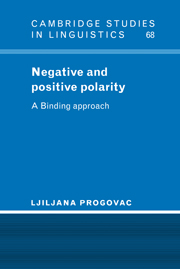Introduction
Published online by Cambridge University Press: 26 January 2010
Summary
This monograph advocates a relativized approach to the bindingtheoretic notions of binder and SUBJECT, making it possible to subsume polarity items under the Binding theory. The Binding theory was primarily designed to cover locality conditions between anaphors and pronominals and their antecedents. I will defend the view that binding/obviation principles only happened to be formulated for reflexives/pronouns first, but that there is no reason to think that they are restricted to them. In fact, in a maximally restrictive model, the same locality conditions should hold for all dependent and anti-dependent phenomena. Since reflexives and negative polarity items are both dependent, they both must be in the scope of (or bound to) their licenser or antecedent, and since pronouns and positive polarity items are both anti-dependent, they both must be interpreted outside of the scope of a local antecedent.
These scope properties of polarity items must be stipulated in other frameworks, but follow directly from the binding analysis. It is a longnoted puzzle that negative polarity items always receive narrow-scope interpretation with respect to negation, and that positive polarity items must receive a wide-scope interpretation with respect to local negation, but either narrow or wide-scope interpretation with respect to superordinate negation. This sets polarity items apart from other quantifiers, which enter freely into scope ambiguities with negation, exhibiting both wide- and narrow-scope readings (cf many and every in (1)).
Information
- Type
- Chapter
- Information
- Negative and Positive PolarityA Binding Approach, pp. 1 - 22Publisher: Cambridge University PressPrint publication year: 1994
